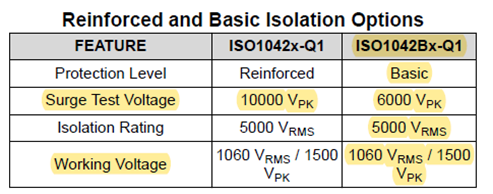Hello team,
Could you pls. help clarify the Leakage current value of ISO1042BQDWVRQ1 when test it under surge/impulse voltage?
We do not find relevant info. in its datasheet.

Thanks.
This thread has been locked.
If you have a related question, please click the "Ask a related question" button in the top right corner. The newly created question will be automatically linked to this question.
Hello team,
Could you pls. help clarify the Leakage current value of ISO1042BQDWVRQ1 when test it under surge/impulse voltage?
We do not find relevant info. in its datasheet.

Thanks.
Hello Daniel,
Thank you for reaching out. The leackage value is covered under the apperent discharge test in the section 6.7 (below). Apparent charge is electrical discharge caused by a partial discharge (pd) test.

The following link may also be helpful [FAQ] What is Partial Discharge, Method a, Method b1, and Method b2 tests? - Isolation forum - Isolation - TI E2E support forums.
Let me know if you have further questions.
Best,
Andrew
Hello Andrew,
Thanks for your support.
But what customer need is leakage current in amps while provided is charge in coulombs,
They cannot calculate the leakage current without knowing the value of the isolation capacitor in ISO1042BQDWVRQ1.
So can you help provide the leakage current directly or share with us how to get this value?
Thanks.
Hi Daniel,
Thank you for the clarification. Please allow me a until Friday to find this information.
Best,
Andrew
Hi Daniel,
Apologies for the delay in response and thank you for your patience.
ISO1042-Q1 datasheet provides barrier capacitance (CIO, 1pF) and insulation resistance (RIO, >1GΩ) in datasheet under section titled Insulation Specifications. For DC stress voltages, please divide the voltage applied with RIO to get the maximum leakage current value and for AC stress voltages, please divide the voltage by "RIO || X[CIO]" where RIO and X[CIO] are in parallel and X[CIO] is the reactance of barrier capacitance that can be expressed as X[CIO] = 1 / 2*π*f*CIO and f is the frequency of AC stress voltage applied.
For working voltage of 1060Vrms with f = 60Hz, X[CIO] is going to be many folds larger than RIO. Thus the total impedance equals RIO. Therefore, the maximum leakage current can be calculated to 1.06µA (= 1060Vrms / 1GΩ).
Let us know if you have any further question, thanks.
Regards,
Koteshwar Rao